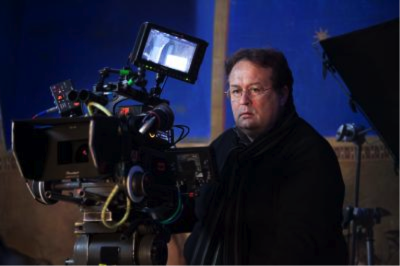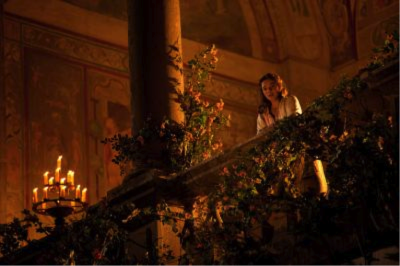By: debbie lynn elias
With well over 150 adaptations and imaginations of what is perhaps Shakespeare’s most famous, and definitely most adapted, work on screen, director Carlo Carlei’s new ROMEO & JULIET is, in a word, masterful. Sparkling as brightly as a Swarovski crystal, Carlei brings the grandeur and majesty of Shakespeare and the legendary story of star-crossed love to life in this luminous version, is nothing short of golden – – as in Oscar gold.
In this new incarnation from Carlei, we have sweeping grandeur and lushness not only visually, but emotionally. Key is that Carlei and screenwriter Julian Fellowes “ push back the story 100 years and set it during the Reign of Sons instead of the end of the Dark Age in the other movie, to take advantage of the beautiful buildings and the color palette of the maestros of the Reign of Sons.” With this temporal shift and thanks to the expertise of cinematographer, David Tattersall, every frame looks like a painting, while Tatersall’s use of light and shadow is breathtaking. Embracing the cinematic feel that the story itself has, Carlei celebrates the visual expansiveness, removing that sense of claustrophobia so often associated with the tale and elevates the beauty of the love story to the heavens thanks in large part to the lyricism of the words, the visuals and Abel Korzeniowski’s sumptuous and sweeping score.
I had a chance to speak with Carlo Carlei in this exclusive interview and talk about the development of what has quickly become my favorite incarnation of ROMEO & JULIET.

Carlo, your ROMEO & JULIET is one of the greatest pleasures that I’ve had watching a movie and this is by far my favorite version of the classic story, and I’ve seen virtually all of them going back to the 1908 silent shorts. No disrespect to Mr. Zeffirelli and his 1968 classic, but pfft!
Thank you. Thank you. It was a movie made in ‘68. That’s fine. It was pretty daring and, of course, today it feels a little bit dated.
One of the important things that you do with this version of ROMEO & JULIET is that you really open up and expand the story and the film. There isn’t a claustrophobic sensibility like what we so often find with reimaginations on the screen and stage. This is very expansive. You do that through the architecture, your production design. I noticed one of the things that you visually do – and I don’t know if you and David Tattersall discussed this when doing your visual design – but when people are running and heading off to places, you have everyone going down stairs. The only person that really goes “up” is Romeo as if he’s reaching up to the heavens. Was all of this visually planned out by you and David?
Not really, but my style, everything I’ve done up until now – I even made the movie that was the most successful mini-series ever on Italian television and also now available here in the States, was the story of a flyer who practically spent all of his life locked into his cell and if not for taking a walk to the church and confess, I managed to make an action movie out of that. How did I do it, I don’t know. Through his memories, when he was a kid, when he was running in the corn fields chased by what he thought was the Devil. I always try to find a way to find a rhythm, a sense of pacing. For me, life is not static. Life is continuous movement. For me, one of the most beautiful love stories of all times is The Last of the Mohicans. I love that movie so much because it kind of reinvented, modernized a genre which was codified in the way that it was dated, in my opinion. When I read the script [ROMEO & JULIET], I thought, “Okay. There’s everything here that we need in terms of emotions. Now, how do I make it spectacular? How do make it visually engaging and absolutely capable of capturing the taste of young people. Young people, you tell them ROMEO & JULIET and they think about something very static or stuffy. They don’t even know what the BBC Masterpiece Theatre is but they would immediately think about something like that. For me, it was absolutely paramount to make the movie that people could enjoy visually and emotionally.
What were some of your visual concerns? You picked David Tattersall as your cinematographer, who is one of the best.
He is one of the best. Because I knew that I had to shoot the movie digitally, I wanted to go to one of the finest of digital cinema. The last trilogy of Star Wars, they started with little Sony cameras and evolved little by little, but David was there to witness and contribute to the evolution of digital cinema. From a technical standpoint, I wanted somebody who knew what we were doing. From an aesthetic point of view, given my choice of shooting the movie during the Reign of Sons, I wanted somebody who was able to capture those colors, to bring that to life. Otherwise you don’t have all those paintings being almost like a constant presence in the movie if you don’t have somebody who knows how to bring to life those colors. Strangely enough, and this will be very funny for you to hear, a movie called Speed Racer by the Wachowski brothers captured my attention in terms of, “Oh my God! I never saw colors so vivid, so real!” So, Speed Racer doesn’t have anything to do with ROMEO & JULIET, yet there was something in that movie that captured my attention and made me absolutely perceive that David was the right guy for my movie.

The lighting play is so key in this film. I can’t think of many films, if any, where you can pick any shot and it could be a still picture because it’s that beautiful. When designing the visual palette, did you and David storyboard or shot list or have discussions on it? The framing is so metaphoric for the emotion.
Thank you. I think that it starts with creating the atmosphere and deciding what kind of light you want. We wanted to be very realistic. We want to use only sources of light that were absolutely in sync with what was available at that time. We didn’t want to force anything. We didn’t want to fake anything. Once you create that atmosphere, then you create a three-dimensional space where wherever you put the camera you were able to capture the essence of that period. Then it’s just a matter of your eye and your taste. I think one of the things that I love the most is to frame. I don’t discuss the framing with the DOP [Director of Photography/Cinematographer]. I discuss the light with him and usually I find every shot myself because that’s the fun of it! I’m a very visual director and I wouldn’t let anybody tell me how to frame my film.
Your framing is flawless with this film. One scene that stands out is the balcony scene. You have Romeo so small in the topiary hedge and slowly you’re panning and zooming and taking the camera upwards. The backlighting of just the torches and the overhead moonlight is stunning. Breathtaking.
We were lucky because we found beautiful locations. Sometimes the location dictates to you if you listen. Locations can have a voice and can tell you, can suggest to you what is the best way. It’s like when somebody tells you, “Frame me from the left because that’s my best profile.” A location, if you look at it, immediately it tells you what is the best way to frame it.
You listened really well! And talking about listening. The score. What led you to composer Abel Korzeniowski? This is such a beautifully thematic score. It’s actually a character unto itself. It really fills “time and space” and helps with the pacing, reminding me of a Bernard Hermann or a Max Steiner. The result is timeless and classic.
I knew that one of the things I had to overcome was that no matter how beautiful the script is and the dialogue is, it’s still pretty classical sounding. For me, I felt that the score should have added another element, an emotional element, that would propel the story in each scene in a way where dialogue would be absolutely important but somehow it would be facilitated in the way it’s perceived and absorbed and decrypted by the audience, by a different dimension which was an emotional score. I think the music is very present exactly like you say, in a Bernard Hermann score, because I wanted it to be a character and given that the movie is period set and the language is classical, it would have been incredibly wrong to have a classical score. In my opinion, Abel is one of those genius composers, one of the few whom I like that was able to do a score that is both classical and contemporary at the same time. It is eternal. It’s like Phil Glass. He’s a classical contemporary composer but his music doesn’t sound like classical music.
What was the most challenging aspect of bringing this version of ROMEO & JULIET to life? It is so distinctive and cinematic.
I don’t think there was anything challenging. I don’t know what challenging means because when it’s about creating a movie, making a movie, nothing scares me. I’m pretty fearless. That’s the only thing I know how to do – well. If you ask me, “Can you please help me to hang that painting?”, I’m absolutely useless. [laughing] The only thing in life, God forbid my car stops and you ask me “What is the problem?” I’ll say, “I don’t know. It just stopped.” But making movies? That’s something I’ve wanted to do since I was 4 years old and I think for me it’s a pleasure. It’s never challenging. It’s always a pleasure. It’s very interesting to find solutions as opposed to scratching my head to say, “This is going to be a challenge.” It’s not a challenge. It’s a pleasure to find a solution. But, I think in the independent world today, independent cinema, the most challenging thing is to put the financing together and to convince people, no matter how passionate or talented you are, that you are the right guy for this job; that the world needs another version of ROMEO & JULIET; that there’s an audience for this kind of movie. Everybody’s a scientist, everybody is a scientist in moviemaking. Everybody thinks that he knows everything. The reality is that I think if you make a beautiful movie that emotionally involves the audience, there is room for that movie. So, the most challenging thing was to put the money together and convince the people who ultimately financed or produced the movie, that this was a worthy project.

I’m so glad to see that Swarovski came in as a producer/financier.
They’ve been incredible. Nadja Swarovski is like a “Reign of Sons” benefactor. [laughing]
I have contributed much to Swarovski’s coffers myself over the years with all the Swarovski crystal pieces and designer jewelry that I have from designers like Heidi Daus who only use Swarovksi in their pieces, plus all the crystal and glass that my mother had that was Swarovski, so it’s nice to see my money was well spent.
So you probably financed my movie in a certain sense! [laughing] You should own a chunk of it!
#
9/25/2013











